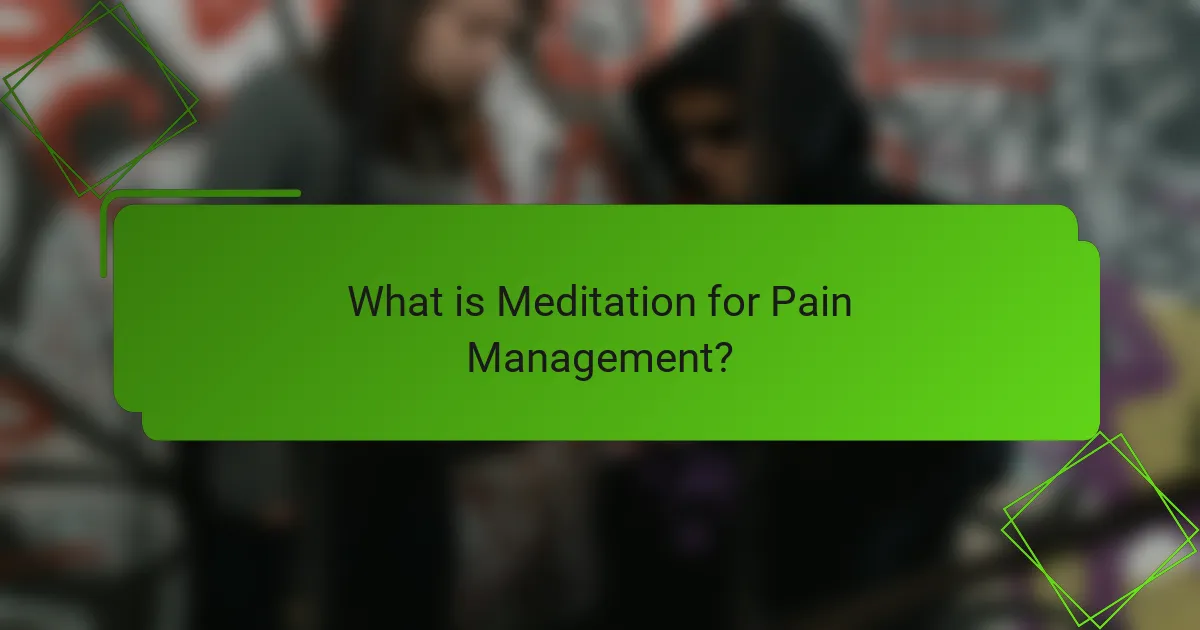
What is Meditation for Pain Management?
Meditation for pain management is a practice that uses focused attention and mindfulness to reduce the perception of pain. It involves techniques such as deep breathing, visualization, and body awareness. Research shows that meditation can activate brain regions associated with pain relief. A study published in the Journal of Pain found that mindfulness meditation significantly reduced pain intensity in participants. Regular practice can lead to lasting changes in pain perception and emotional responses. This makes meditation a valuable complementary approach in pain management strategies.
How does meditation help in managing pain?
Meditation helps in managing pain by altering the perception of pain and promoting relaxation. It reduces stress and anxiety, which can exacerbate pain sensations. Mindfulness meditation teaches individuals to focus on the present moment. This practice can decrease the emotional response to pain. Research indicates that meditation can activate brain regions associated with pain modulation. A study published in the Journal of Pain found that participants reported lower pain levels after engaging in mindfulness meditation. Regular meditation practice can lead to long-term changes in pain perception. These changes may enhance overall pain management strategies.
What are the physiological effects of meditation on pain perception?
Meditation reduces pain perception through various physiological mechanisms. It activates brain regions associated with pain modulation, such as the anterior cingulate cortex and the insula. Research indicates that meditation can decrease the perception of pain intensity. A study published in the Journal of Neuroscience found that mindfulness meditation reduces pain by altering the brain’s response to painful stimuli. Participants reported lower pain levels during meditation sessions compared to control groups. Additionally, meditation enhances the release of endorphins, which are natural pain-relieving chemicals in the body. This biochemical response contributes to a greater sense of well-being and lower pain sensitivity. Overall, meditation serves as an effective tool for managing pain perception physiologically.
How does meditation influence mental health in relation to pain?
Meditation positively influences mental health in relation to pain by reducing stress and enhancing emotional regulation. It encourages relaxation, which can lower the perception of pain. Research indicates that mindfulness meditation can decrease pain sensitivity and improve coping strategies. A study published in the journal Pain found that participants who practiced meditation reported lower pain levels and improved mood. This suggests that meditation may alter the brain’s response to pain signals. Furthermore, consistent meditation practice can lead to long-term changes in how individuals process pain.
What techniques are used in meditation for pain management?
Mindfulness meditation, guided imagery, and body scan are techniques used in meditation for pain management. Mindfulness meditation focuses on being present and observing thoughts without judgment. This practice can reduce the perception of pain by promoting relaxation. Guided imagery involves visualizing peaceful scenes to distract from pain sensations. Studies show that this technique can lower pain levels significantly. Body scan meditation encourages awareness of bodily sensations, helping individuals to release tension. Research indicates that these techniques can enhance pain tolerance and improve overall well-being.
What are the most common meditation techniques for pain relief?
The most common meditation techniques for pain relief include mindfulness meditation, guided imagery, and body scan meditation. Mindfulness meditation focuses on being present and aware of thoughts and sensations without judgment. Studies show it can reduce chronic pain by altering the perception of pain. Guided imagery involves visualizing peaceful scenes to promote relaxation and distract from pain. Research indicates it can effectively decrease pain levels. Body scan meditation entails paying attention to different body parts and releasing tension. This technique has been shown to enhance body awareness and reduce discomfort.
How can mindfulness meditation be applied to pain management?
Mindfulness meditation can be applied to pain management by enhancing awareness of pain and reducing its perception. This practice encourages individuals to observe their pain without judgment. By focusing on the present moment, mindfulness helps decrease anxiety and stress associated with pain. Studies show that mindfulness meditation can lead to significant reductions in chronic pain. Research published in the journal “Pain” found that participants who practiced mindfulness reported lower pain levels and improved coping skills. Mindfulness meditation trains the brain to respond differently to pain signals. Regular practice can improve emotional regulation and resilience in the face of discomfort. Overall, incorporating mindfulness meditation into pain management strategies can enhance overall well-being.
What are the benefits of meditation for pain management?
Meditation offers several benefits for pain management. It can reduce the perception of pain by altering the brain’s response to pain signals. Research shows that mindfulness meditation can decrease pain intensity and improve pain tolerance. A study published in the Journal of Pain found that individuals practicing meditation reported lower pain levels. Additionally, meditation promotes relaxation, which can alleviate muscle tension and reduce pain. It also enhances emotional regulation, helping individuals cope better with chronic pain. Furthermore, regular meditation practice can lead to long-term changes in brain structure associated with pain processing.
How does meditation contribute to overall pain reduction?
Meditation contributes to overall pain reduction by altering the perception of pain and enhancing coping mechanisms. It activates brain areas associated with pain modulation. Research shows that mindfulness meditation can decrease pain intensity. A study published in the Journal of Pain found a 29% reduction in pain levels among participants practicing mindfulness. Additionally, meditation promotes relaxation, which can reduce muscle tension and stress-related pain. Techniques such as focused attention and body scanning enhance awareness of bodily sensations. This increased awareness can lead to better emotional regulation and decreased anxiety related to pain. Overall, meditation serves as a valuable tool in pain management strategies.
What psychological benefits does meditation provide for chronic pain sufferers?
Meditation provides several psychological benefits for chronic pain sufferers. It helps reduce anxiety and depression, which are common in individuals dealing with persistent pain. Mindfulness meditation encourages a greater awareness of the present moment. This practice can lead to improved emotional regulation. Studies show that meditation can enhance pain tolerance and decrease the perception of pain. Research published in the journal Pain by Zeidan et al. (2012) found that participants who engaged in mindfulness meditation reported lower pain intensity. Meditation also fosters a sense of control over pain, promoting a more positive outlook. Overall, these benefits contribute to improved quality of life for chronic pain sufferers.

How long should meditation sessions be for effective pain management?
Meditation sessions for effective pain management should typically last between 10 to 30 minutes. Research indicates that even short sessions can lead to significant pain relief. A study published in the Journal of Pain found that participants experienced reduced pain levels after meditating for just 20 minutes. Longer sessions, around 30 minutes, may enhance the benefits, allowing deeper relaxation. Consistent practice is essential for maximizing pain management effects. Regular meditation can help rewire the brain’s response to pain over time.
What is the recommended duration for meditation sessions focused on pain relief?
The recommended duration for meditation sessions focused on pain relief is typically between 10 to 30 minutes. Research indicates that sessions of this length can effectively reduce pain perception. A study published in the journal Pain Medicine found that participants experienced significant pain relief after 20-minute sessions of mindfulness meditation. Additionally, shorter sessions may be beneficial for beginners, while longer sessions can enhance the effects for those more experienced in meditation.
How does session length impact the effectiveness of meditation for pain management?
Session length significantly impacts the effectiveness of meditation for pain management. Longer meditation sessions often lead to greater reductions in pain perception. Research indicates that sessions lasting 20 minutes or more can enhance relaxation and mindfulness, which are crucial for pain relief. A study published in the Journal of Pain found that participants who engaged in longer meditation sessions reported a 30% decrease in chronic pain symptoms. In contrast, shorter sessions may not provide sufficient time for the body to enter a state of deep relaxation. Thus, optimal session length is essential for maximizing the benefits of meditation in pain management.
What factors influence the duration of meditation sessions?
The duration of meditation sessions is influenced by several factors. Personal experience level plays a significant role. Beginners may meditate for shorter periods, while experienced practitioners often extend their sessions.
The type of meditation practiced also affects duration. Techniques such as mindfulness may vary in length compared to transcendental meditation.
Environmental factors can influence session length as well. A quiet, comfortable setting encourages longer meditation. Conversely, distractions may shorten the duration.
Individual goals are another factor. Those meditating for stress relief might choose longer sessions compared to those seeking quick relaxation.
Physical comfort is crucial too. Discomfort can lead to shorter sessions.
Lastly, time availability directly impacts how long one can meditate. Busy schedules often limit session duration.
How do individual pain levels affect meditation session length?
Individual pain levels significantly influence meditation session length. Higher pain levels can lead to shorter meditation sessions. Individuals experiencing intense pain may struggle to focus, causing them to end sessions prematurely. Conversely, those with lower pain levels often find it easier to engage in longer sessions. Research indicates that pain can distract from meditation practices, reducing overall effectiveness. A study published in the Journal of Pain found that patients with chronic pain reported shorter meditation durations compared to those without pain. Thus, individual pain levels directly correlate with how long one can meditate effectively.
What role does experience with meditation play in determining session length?
Experience with meditation significantly influences session length. More experienced practitioners tend to meditate for longer durations. This is due to their increased comfort with the practice and ability to maintain focus. Beginners often start with shorter sessions, typically around 5 to 10 minutes. In contrast, seasoned meditators may engage in sessions lasting 30 minutes or more. Research indicates that experienced meditators develop greater mental endurance over time. This endurance allows them to extend their practice without feeling overwhelmed. Therefore, experience plays a crucial role in determining how long individuals can effectively meditate.

What practical tips can enhance meditation for pain management?
To enhance meditation for pain management, focus on specific techniques and environments. Start with a comfortable position to reduce physical tension. Use guided meditations designed for pain relief. Incorporate deep breathing exercises to promote relaxation. Set a consistent schedule for daily practice to build a routine. Experiment with different meditation styles, such as mindfulness or body scan, to find what works best. Create a dedicated space free from distractions to enhance focus. Research shows that regular meditation can reduce chronic pain perception (Goyal et al., 2014, JAMA Internal Medicine).
How can one create an optimal environment for meditation sessions?
To create an optimal environment for meditation sessions, ensure a quiet and comfortable space. This minimizes distractions and promotes focus. Use soft lighting to create a calming atmosphere. Natural light or dimmed lamps can enhance relaxation. Maintain a comfortable temperature in the room. A temperature range of 68-72°F is often ideal for comfort. Incorporate comfortable seating or cushions to support the body during meditation. This helps maintain posture and reduces discomfort. Adding calming scents, like lavender or sandalwood, can enhance the meditative experience. Research indicates that pleasant aromas can positively influence mood and relaxation. Finally, limit electronic devices in the space. This reduces interruptions and distractions, allowing for deeper meditation.
What mindfulness techniques can be integrated into daily routines for pain management?
Mindfulness techniques for pain management include deep breathing, body scans, and mindful movement. Deep breathing helps reduce tension and promotes relaxation. It can be practiced anywhere, making it easy to integrate into daily routines. Body scans involve focusing attention on different body parts to identify and release tension. This technique enhances body awareness and can be done lying down or sitting comfortably. Mindful movement, such as yoga or tai chi, encourages gentle physical activity while maintaining a focus on the present moment. Research shows that these techniques can decrease pain perception and improve overall well-being. Mindfulness practices have been linked to lower levels of stress and anxiety, which can further alleviate pain.
Meditation for pain management is a practice that utilizes focused attention and mindfulness to alleviate pain perception. This article explores various meditation techniques, such as mindfulness meditation, guided imagery, and body scans, highlighting their physiological and psychological benefits in reducing pain intensity and enhancing emotional regulation. It also discusses the optimal session length for effective pain relief, practical tips for creating a conducive meditation environment, and the integration of mindfulness techniques into daily routines to improve overall well-being. The findings underscore meditation’s role as a valuable complementary approach in pain management strategies.